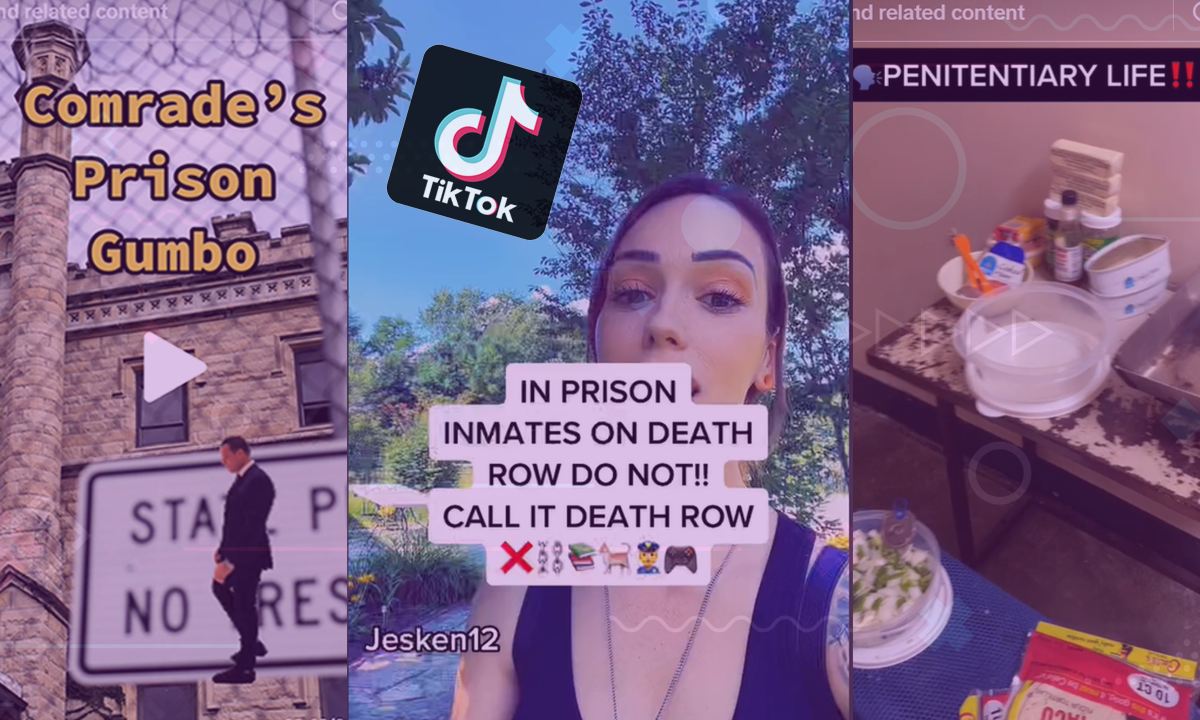How to Cook Sausage When You’re Locked in a Cell
Inside the viral phenomenon of prison TikTok. Image: Truthdig
Image: Truthdig
Jessica Kent, a TikTok influencer with impossibly shiny hair and giant brown eyes, smiles into her iPhone camera and wags her finger at her 1.3 million followers. “Did you know that in prison, the inmates who are on death row don’t actually call it death row?” she says, in a chipper tone. Kent spent seven years behind bars on a drug and weapons charge, she explains. “Let’s go!” she adds, and points the camera at her friend and TikTok collaborator Michael Lacey, 45, known as Comrade Sinque on the site.
Lacey, who spent 21 years in prison, pops in front of Kent’s phone camera. “They actually call it X row,” he says in the video. “I believe strongly that it has to do with the psychological effects that that term [death] can have on that population,” he explains. At the start of his sentence, he’d been assigned to work on death row. He was a GED tutor. “Yes, people on death row — X row — do require GED tutors,” he adds.
Why in the world do death, or rather, X-row inmates bother getting their GEDs? Lacey used to get that question a lot on his TikTok, he tells Truthdig. “Usually, it was people being snarky.” He cites two reasons: First, people like to learn, out of plain curiosity. He himself audited history and anthropology courses, despite the unlikelihood of working in either field. But the main reason? “They do it for their loved one’s on the outside, their moms, wives, daughters.”
“One guy I got close with … he wanted to get his GED certificate so his moms would have the certificate before he went.”
Lacey and Kent’s joint TikTok post, under a minute long, has 54.9K likes and 301 comments, starting with Kent’s strong denunciation of capital punishment, delivered in Digital-ese. “Idk who needs to hear this but many are innocent & our gov. Shouldn’t be allowed TO KILL ANYONE!”
Using the platform, former inmates such as Lacey and Kent detail their journey to freedom and dispel myths about prison.
They’re part of a viral phenomenon of former and current inmates who use TikTok to share stories about life behind bars. The content gets huge visibility — TikTok is the most popular short video app in the world.
Using the platform, former inmates such as Lacey and Kent detail their journey to freedom and dispel myths about prison. Did you know that contrary to popular belief, inmates rarely use shivs? They’re more likely to put a metal lock in a sock as a weapon.
It’s not just former inmates that post. Prison TikTok, a trending source of such information, comes to us courtesy of smuggled-in burner phones. In one post, the soundtrack to “Mission Impossible” plays as a very large man stuffs illegal cellphones in his armpits ahead of a guard check. Getting caught with an illegal phone in prison is a felony. But that hasn’t stopped a bustling black market from developing — including the creative use of drones from people on the outside.
The videos are mostly horrifying: footage of “last man standing” fights, harrowing images of the “food” served behind bars. “I’ll just eat the cake. The rest looks iffy,” one inmate says, showing a styrofoam tray filled with brown mystery sludge ladled over rice. In another video, gospel music plays as a man glances off to the side against the backdrop of his corrugated metal prison cot. Overlaid on the footage is text saying, “when you been waiting on them to call your name to go home and be free after 17 years, but they keep calling everybody else.”
They also show people behind bars being weird and having fun — the hallmark of TikTok. In one video, five guys in a cell crowd in front of a camera for a viral challenge. “Let’s try this trend,” a Siri robot voice intones. “Who got the most hoes?” The men laugh and point to a very handsome young guy, who gives a guilty-as-charged grin. “Who can you count on to be there when you need them?” In unison, they all point to another man in the video.
Why do prisoners risk a felony to post on TikTok? Keri Blakinger, a reporter who spent two years in a New York prison, says that it feels like a fun and slightly subversive outlet. “For a lot of people, clandestine social media posts from prison might be the only way to draw attention to inhumane and unlivable conditions,” she says.
The novelty of the form, not to mention its entertainment value, creates an unprecedented space for education and change. By now, most people are familiar with the horrid criminal justice statistics that circulate in media and policy spaces: America incarcerates more people than any country on Earth. But did you know how to cook a sausage in a prison cell using a plastic cup, some wires and saran wrap? “I put it in some water like this … and I plug that thing up,” @Mister-Booker says, dropping a succulent treat encased in plastic into a styrofoam cup. The water starts boiling. “I’m probably gonna leave this thing in for 20 minutes, till it gets good and juicy. Look at that!” he says proudly.
“Man and His Search for Meaning.”
More than two decades ago, when you couldn’t even text on a cell phone, Lacey sat in an Indianapolis jail cell, convinced that the cops were lying in order to intimidate him. They said he was being charged with murder even though he hadn’t killed anyone. “I thought they were using it as leverage,” he tells Truthdig.
He and a friend had tried to rob a house. The homeowner caught them and shot his friend, improbably putting Lacey on the hook for his friend’s death.
In a felony murder case, anyone involved in the crime can face homicide charges, even if they didn’t pull the trigger. Usually the charges are applied, when, say, a gas station attendant is killed in a robbery. But Lacey’s case was odd. Even as he grieved his friend, he was in deep trouble for his death, despite the fact that another man had killed him. “Imagine my surprise when the lawyer told me that, yes, they can do that,” he tells Truthdig.
He decided to contest the charges at trial. The odds were not in his favor. “The judge was white, the prosecutor was white, the lady typing was white, the jury was white … “
Lacey explained how felony murder charges work: that you can be charged with murder despite not murdering anyone. The post got 9,398 likes and a lot of strong reactions.
Lacey, who is Black, was sentenced to 60 years in prison. The blows kept coming. Just a week into his prison term, Lacey found out that his brother had been killed. His mother was in the visiting room when she got the call. “She went from visiting me, serving 60 years, and then going straight out to identify the body of her only other child,” he tells Truthdig.
Early in his prison term, Lacey came across Viktor Frankl’s book, “Man and His Search for Meaning,” the 1946 chronicle of Frankl’s time as a prisoner in a Nazi concentration camp. “It was a gift from the universe,” he tells Truthdig. “If you believe you have a hopeful future, it makes what’s going on presently a little less burdensome.”
The book changed his perspective. For one thing, he realized that the men on “X” row, whom he tutored in high school reading and math, would do anything to get 60 years behind bars, instead of a trip to the lethal injection gurney. Ditto for the lifers. He decided to make the best of things. He buried himself in books. “I read 1,700 books,” he tells Truthdig. He composed poetry and made collages. He wrote movie scripts.
Lacey was right to keep up hope. He was paroled in 2022 after serving 21 years. He got a smartphone. After a 40-minute tutorial from a friend, he downloaded TikTok, using the handle Comrade Sinque, to share his stories.
It blew up. He has 944.7k followers. They include the supermodel Bella Hadid, the actress and activist Alyssa Milano, actress Trisha Campbell, The Innocence Project and someone named Addison Rae, a 22-year-old influencer, actress and Emily Ratajkowski look-alike, who neither of us had previously heard of because we’re both in our 40s. She has 88 million followers. “Did you know that Addison Rae liked your post?” a younger friend gushed. “Who the fuck is that?” he recalls replying (since then, he’s become well-acquainted with Rae — the connection recently got him a gig shooting photos at a teenager’s birthday party when his young client was impressed that he had such a famous follower). In his regular life, Lacey makes his living doing freelance photography and videography.
“Can you talk about the event that got you in prison?” a follower recently wanted to know. Lacey explained how felony murder charges work: that you can be charged with murder despite not murdering anyone. The post got 9,398 likes and a lot of strong reactions.
“That is an insane law!! WHAT!?!?,” wrote one follower.
“21 years? You don’t even look 21 😳” another follower wrote.”
“Love you,” another commented. “Sorry about your friend.”
In a recent video, Kent, Lacey’s friend and sometimes TikTok collaborator, films herself strolling down a tree-lined street. “Fun fact about me?” she asks chirpily — again, in a tone that makes you think she’s going to tell you about her aversion to carbs.
“When I was in prison, what I missed the most, was ice-cold water and going on walks whenever I wanted to,” she says. “Sometimes, in the yard, you could walk around the yard, and try to pretend you’re not in prison,” she adds in a singsong voice. “But that vibe’s always there. The radio, the keys …,” she sighs. “So I don’t take anything for granted, especially a nice walk on a warm summer day.”
“I should probably brush my hair though!” she adds, laughing at her image in the cellphone camera.
Your support matters…Independent journalism is under threat and overshadowed by heavily funded mainstream media.
You can help level the playing field. Become a member.
Your tax-deductible contribution keeps us digging beneath the headlines to give you thought-provoking, investigative reporting and analysis that unearths what's really happening- without compromise.
Give today to support our courageous, independent journalists.






You need to be a supporter to comment.
There are currently no responses to this article.
Be the first to respond.